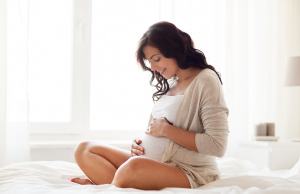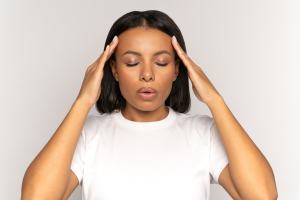
- Anxiety symptoms are unpleasant effects caused by anxiety disorders.
- Each anxiety disorder has unique effects, but many of them also share common symptoms, which include feeling on-edge, panicked, irritable, guilty, or fatigued.
- Triggers of anxiety disorders include physical health conditions, financial stress, interpersonal conflict, life transitions, and more.
- The DSM-5 offers a comprehensive, universally recognized set of criteria for each anxiety disorder, which clinicians use to diagnose and treat patients.
- The physical symptoms and warning signs of anxiety include muscle pain, weakness, nausea, sweating, trouble concentrating, difficulty sleeping, withdrawal from favored activities, relationships, and more.
To be occasionally anxious is to be human. But wrestling with anxious thoughts every now and again is a far cry from the symptoms of clinical anxiety.
Below, we explore and define the symptoms, triggers, and warning signs of common anxiety disorders, and more. Being able to recognize anxiety symptoms doesn’t just increase your mental health awareness; it may improve your ability to cope and help you recognize the need for a provider’s assistance in your recovery from anxiety.

What Are Common Symptoms of Anxiety?
Chances are, you’ve been nervous, worried, or stressed out before. Those feelings typically pass within a short span of time. But with anxiety disorders, the symptoms last much longer and are more intense to endure, becoming a chronic condition.
With many mental health conditions, including anxiety disorders, we might feel safer pretending that they only affect others, even if we say we support destigmatizing mental health.
Yet statistics paint a far different picture, in which nearly ⅓ of U.S. adults will face some type of anxiety disorder in their lifetime.
Despite the differences between different anxiety disorders, there are some classic, common symptoms, which include the following:
- Feeling nervous, on-edge, or overstimulated
- Panic attacks, or a strong sense of impending danger, death, or doom
- Sensations of weakness or fatigue
- Rapid or irregular heart rate
- Uncharacteristic irritability
- Feelings of guilt or hopelessness
Beyond these general indicators, it’s also helpful to know the triggers and presenting symptoms of some of the most common anxiety disorders as clinically recognized by mental health professionals using the DSM-5.
What Triggers Anxiety Disorders?
Before an anxiety disorder develops, the individual will experience an event or situation that repeatedly triggers their anxious responses. As a result, understanding what triggers anxiety is an essential aspect of mental health awareness and treatment. Anxiety disorders may be triggered by the following, when severe enough:
- Debilitating health conditions: Concerns about one’s physical wellbeing can stir up anxiety, especially with chronic or terminal illnesses that are a day-to-day ordeal.
- Poor reaction to certain medications: Some people may not respond well to certain medications, which affect their ability to calm themselves down or regulate their thoughts in a healthy manner. However, sometimes starting a new medication, or concerns about a current prescription drug’s effects can trigger anxiety.
- Caffeine consumption: As one of the most commonly used psychoactive drugs, many people do not fully realize the potent physiological effects that caffeine intoxication has on the nervous system. Caffeine may overstimulate those who are sensitive to this drug, causing anxiety.
- Sleep deprivation and poor sleep hygiene: A regular sleep schedule helps ensure that our minds and bodies are able to heal and be rejuvenated, but when our sleep patterns get disrupted, or we start to become sleep deprived, anxiety and irritability will eventually creep up on us.
- Caloric deficit: When the body is in a caloric deficit, one’s emotional state can be aggravated, making anxiety an unwelcome side effect of hunger.
- Negative thinking: For people with trust issues, unresolved trauma, who are going through difficult life transitions, or who have difficulty with authority figures, negative thoughts can create anxiety because they snowball into cognitive distortions. This is a psychological term for thought patterns that are not grounded in reality and lead to reduced quality of life for the individual suffering from them.
- Financial hardships: Financial stress is ranked as the top concern for Americans, and can be a trigger of anxiety.
- Social gatherings: For those who are self-conscious, introverted, or who are neurodivergent, social gatherings can cause significant anxiety, as these individuals may struggle to connect with others, or may misread social cues and body language in ways that make it difficult for them to form personal relationships.
- Interpersonal conflict: Even those who don’t suffer from social-related anxiety can find themselves in the midst of an interpersonal conflict. A falling out with a friend, family member, partner, or coworker can present significant mental health challenges to anyone, especially if the interpersonal conflict affects their home life, career, or ability to be financially independent.
- Life transitions: Life transitions can take many forms, but are identified as milestones or changes that affect someone’s life in a significant way. Change of any kind may be a trigger of anxiety—life transitions can include divorce, marriage, having a child, enrolling or dropping out of college, the death of a loved one, development of a terminal illness, or moving to a new location.
- Personal aspirations: Sometimes stress can be a good thing, driving us toward the people, careers, accomplishments, and special moments that we desire. But too much pressure on oneself to reach a personal goal can create undue anxiety, which means that being ambitious, while it’s a helpful and extremely useful state of mind, can trigger anxiety.
DSM-5 Criteria for Anxiety Disorder Symptoms
Each anxiety disorder has a different set of symptoms, typically clustered together in a way that makes them clinically recognizable by mental health professionals.
Anxiety symptoms: Generalized anxiety disorder (GAD) DSM-5 300.02 (F41.1)
GAD usually entails a persistent feeling of doom, dread, and worry, which heavily affects daily life. Those who have GAD experience their anxiety symptoms for months, or even years. Symptoms include:
- Difficulty concentrating
- Racing thoughts
- Trouble sleeping
- Muscle tension
- No clear recognizable trigger for their anxiety symptoms
- Irritability
- Muscle tension
Symptom specifications: Anxiety and worry are accompanied by at least three of the above physical or cognitive symptoms (in children, only one of these symptoms is necessary for a diagnosis of GAD). Must be present for at least 6 months or more.
Anxiety symptoms: Substance/medication-induced anxiety disorder
This form of anxiety occurs after one has taken an illicit substance or prescribed medication, and can happen in cases of addiction. Substance/medication-induced anxiety disorder can occur during intoxication, withdrawal, or routine medication use. Symptoms may appear as:
- Confusion or agitation
- Aggression, lack of bodily or spatial awareness
- Elevated heart rate
- Derealization
- Fear of death or insanity
- Difficulty breathing or communicating
Symptom specifications: Must not be better explained by an anxiety disorder that is not substance-induced, and anxiety symptoms only manifest during intoxication, withdrawal, or routine medication usage. Symptoms must also be present when not in a state of delirium. Additionally, the individual’s anxiety causes distress or impairment in everyday life, including work, relationships, self-care, and more.
Anxiety symptoms: Panic disorder DSM-5 300.01 (F41. 0)
Panic disorder causes both predictable and unpredictable recurrent panic attacks. The intensity of the panic attack is a source of alarm and can cause extreme psychological unrest and may result in an emergency room or hospital visit, as panic attacks may mimic cardiac arrest. Panic disorder symptoms include:
- Depersonalization—the persistent feeling of observing oneself or having a sense their one’s surroundings aren’t real,
- Derealization—a mental state in which one feels detached from the surrounding environment.
- Fear that anxiety symptoms will cause death or insanity
- Chest pain
- Light-headedness
- Difficulty breathing, fear of choking
- Paresthesias—tingling in extremities and skin
- Sweating
- Nausea and vomiting
- Fainting in extreme cases
Symptom specifications: Must last 6 months or more. Panic attacks must reach a peak within a few minutes, during which four (or more) of the above must symptoms occur. Additionally, at least one panic attack must be followed by worries about additional panic attacks and/or significant maladaptive changes, such as substance use, overexercise, and superstitious behavior.
Anxiety symptoms: Separation anxiety disorder DSM-5 301-29 (F 93.0)
Separation anxiety disorder affects both children, teens, and adults, who suffer from intense fear related to being apart from the people to whom they are most attached. They are frequently concerned that something terrible will happen to their loved ones if they are separated, in many cases, even if only for a brief period of time. Symptoms include:
- Worries of losing attachment figures, due to natural disasters, car accidents, disease, murder, arrest, etc.
- Concerns about being separated due to personal events, such as being kidnapped, getting lost, being abandoned, and more
- Refusal or unease about attending school, social gatherings, work, and other obligations that require separating from attachment figures
- Difficulty sleeping and experiencing nightmares about separation
- Physical symptoms, including nausea, headaches, stomachaches, and more
- Refusal to form significant social bonds with non-attachment figures
Symptom specifications: Must be present for at least 4 weeks in children/adolescents and typically 6 months in adult clients, and include at least 3 of the above symptoms.
Anxiety symptoms: Social anxiety disorder 300.23 (F40.10)
Social anxiety disorder revolves around someone’s fear of being rejected, mocked, or judged by others in public and private social settings. People with social anxiety may go out of their way to avoid going to work, attending school, or doing everyday things like grocery shopping. A more specific subtype of social anxiety is agoraphobia, a fear of public spaces, such as buses, libraries, sports arenas, etc. Social anxiety disorder sufferers may be:
- Intensely fearful of interacting with others outside of one-on-one interactions or with more than a few individuals
- Marked fear of being judged by others
- Overly fixated on “fitting in”
- Overly concerned about other people noticing their social anxiety
- Prone to blushing when anxious, a hallmark feature of social anxiety disorder
- Avoidant of public speaking, or standoffish due to their inner turmoil in public settings
Symptom specifications: Must last at least 6 months or more, are not drug-induced, not related to another mental health condition, and are not related to legitimate concerns about being judge due to physical disfigurement from an injury (i.e. burns) or degenerative disease, such as Parkinson’s. In children, social anxiety must also occur with peer-to-peer interactions, not just with adults. Social situations must always provoke intense fear and anxiety.
Anxiety symptoms: Selective mutism 312.23 (F94.0)
Selective mutism is a social-related disorder, which is similar in nature to social anxiety disorder and is most often seen in children. One of the crucial differences is that selective mutism develops typically before the age of 5. Antisocial behavior, a clingy personality, and temper tantrums are not uncommon, but the primary symptom of this disorder is the unwillingness to speak in front of unfamiliar or untrusted individuals. People with selective mutism are more likely to be diagnosed with other anxiety disorders, as well. Presenting symptoms are:
- Refusal to speak in appropriate settings, including academic courses, conversations, and when being addressed by others
- Clear preference over immediate family members or caretakers, who are typically the only ones the individual will speak to
- Anti-social behavior, and anger, even rage at being forced to communicate
- Lack of social connections or desire to make friends with other children
- Extreme attachment to parental figures
- Extreme shyness
- A lack of contact with other individuals other than parental figures, usually by choice
Symptom specifications: At least 1 month or more, and the individual’s behavior must not be better explained by a different disorder.
What Does Anxiety Feel Like Physically?
Like many other mental health conditions, anxiety has the ability to cause physical health effects, many of which are unpleasant to experience. Some of the most commonly reported physical symptoms of anxiety are:
- Stomach pain, nausea, or digestive trouble
- Headache
- Insomnia or other sleep issues
- Fatigue
- Shortness of breath or hyperventilation
- Increased heart rate
- Sweating
- Muscle pain
The physical symptoms of anxiety may be ignored without treatment; and often, we are routinely unaware of how our emotions affect our physical health. Though uncomfortable, the physical symptoms of anxiety usually subside once the individual’s cognitive symptoms are treated.
What Are Common Warning Signs of Anxiety?
Like any mental health condition, the warning signs of anxiety may build slowly over time. These red flags, so to speak, may start small but escalate into unhealthy and possibly even impulsive behaviors that come about as a result of unresolved anxiety. Some of the most common warning signs of anxiety may resemble:
- Worrying and feeling guilty without knowing exactly why
- Eating or sleeping too much, or not enough
- Lack of interest in the people and things you once valued
- Headaches
- Failing to thrive in your home life or career
- Feeling nervous, restless or tense
- Irrational fear of danger, death, or doom
- Rapid heart rate
- Hyperventilation
- Sweating
- Trembling
- Feeling weak or tired
- Trouble concentrating
- Trouble sleeping
- Gastrointestinal issues
- Strong urges to avoid the things that trigger your anxiety
If you are experiencing any of these warning signs of anxiety, it could be beneficial and alleviating to talk with a mental health professional about what could be an anxiety disorder. Reaching out to seek help via therapy or psychiatric care can offer you assistance, a new perspective, and a rejuvenated sense of confidence. We all need a little help sometimes.













